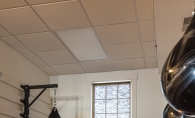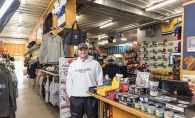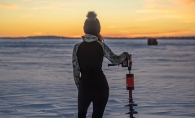Some of Maureen Bausch’s fondest football memories have taken place at Pony Stadium. Years ago, as Bausch (then Maureen Hooley) performed with the Stillwater Area High School Chavel dance line team during halftime shows at football games, no one could have predicted that one day this outgoing teenager from the class of 1972 would lead the biggest football event in the world—the Super Bowl. Not even Bausch herself.
Fast forward to the present. As CEO of the 2018 Minnesota Super Bowl Host Committee, Bausch is leading Minnesota’s efforts to host an event that will showcase the state, attract 5,000 sports and lifestyle media outlets from around the world, draw an estimated one million visitors to the Twin Cities, and, if successful, help springboard a $400 million-plus economic boost locally.
Super Bowl LII will be played in the Vikings’ new U.S. Bank Stadium in downtown Minneapolis, which is scheduled for completion later this year. With work on the event well underway, Bausch offers a behind the scenes look into the planning process and shares her fond memories of growing up in the St. Croix Valley.
Pony Pride
You come from a deeply rooted Stillwater family.
Yes, my family has been there for years. My great-great grandfather had a supermarket, Hooley’s Meats & Provisions, way back in the lumberjack days. Then my family had Hooley’s Supermarket (where I worked as a cashier), and then Cub Foods. My father, Charles Hooley [co-founder of Cub Foods], also had a large meat plant that delivered meat throughout the Midwest.
What are your memories of growing up in Stillwater?
When I tell people about Stillwater and describe it, it’s almost like a Norman Rockwell village when I grew up. You could ride your bike all over town. It was safe. And on Halloween, we lived on the south hill but you could go all the way to the north hill. You could walk or ride your bike almost anywhere, and we did. It’s different than growing up in a large city. I go back there almost every week to see my parents or to visit the town. It’s a beautiful place to go for wonderful restaurants, walking or whatever.
Do you still have family in the area?
Absolutely. I’m the oldest of six. I have quite a few cousins and a close family—nine of them live in Stillwater, others are in the Twin Cities area and one sister lives in Michigan.
I heard that you were a Chavel at Stillwater Area High School.
It was my only claim to fame and believe me, I was not their best one. Let’s just say the NFL won’t be asking me to participate in the halftime show! It was different back in those days. We didn’t have quite the outfits that they wear today, but I think we had all of the athletic moves. It was a fun group.
What do you remember most about Pony football games?
It really was a focus of the fall season. It was a fun activity and I loved the fact that the parents would all go, and the families and brothers and sisters. Everyone would come out for the Pony football games, and I’m sure they still do. It was like that for basketball and hockey too, but it seemed that football was all about fall and [it was] a great sport that brought everyone together.
Road to the Super Bowl
What did you do after high school?
I earned an elementary education degree from the University of Minnesota—Duluth and then taught school. Then I went to work with my father at Cub Foods. I started as his assistant and then went into advertising and learned marketing from my cousin John, who was a great marketer and who eventually became CEO. Cub was growing during those years at a lightning speed.
And then you joined the Mall of America?
Yes. I went back to the U of M to get a master’s degree in marketing and journalism. After 13 years, I really wanted to try marketing something other than food. I heard about the new mall opening and they wanted to hire someone from this market who understood market entry. I worked there for 25 years and held several different positions until my most recent position as EVP business development.
How did you connect with the NFL?
During my tenure [at MOA], we did the naming rights for the fields, and I knew the power of the Vikings and the NFL brand. The brand association was absolutely remarkable. We went through a recession in 2008-2009—and MOA marketed through it—but the biggest difference was that we were partners with the Vikings. We were probably one of the very few retail businesses in the country that actually saw an increase during the recession. I was very impressed with the Vikings organization and their marketing team, led by Steve LaCroix [executive vice president and chief marketing officer]. When the Super Bowl was announced, I had a lot of interest in the whole process. When they asked if I would like to do it, I was ready for a change. It’s fun to try something new.
The Big Event
How big is your planning team?
Eventually we’ll grow to about 30, but right now we have about five. There are very specific skills that are needed to execute this event, and fortunately the NFL gives us a great playbook.
Will there be volunteer opportunities?
Absolutely! Eventually, we’ll need 9,000 volunteers. People can register online to get updates and learn about volunteer opportunities. Every single volunteer will need to be interviewed. They’ll get a great uniform, like an Olympic uniform—it’s very cool.
What’s happening now?
We’re building our partner base [sponsors]. We know that it’s a moving target, but we love talking about the excitement and how we’ll position Minnesota to the world. If we do this right, the market should see more events, conventions and meetings. It does show a real positive economic impact. And we’re creating a 10-day festival that leads to the Super Bowl and we’ll market that to the Midwest and Canada. People will come in during the first part of the week for activities such as the NFL Experience, Radio Row, and the Winter Carnival in St. Paul [which will coincide with the Super Bowl in 2018].
How does the stadium fit into the plans?
One of the main reason we won the bid is that we have this bold new stadium. We’ve created a theme for the Super Bowl, “The Bold North,” and the stadium’s design [ties in] with its Scandinavian elements. It looks like it has a shard, or a peak out in the front. Once it opens, we will work closely with the stadium. For example, we’ll add additional seats for the Super Bowl—we go up to 70,000 seats for the game and the stadium will typically hold approximately 66,000.
Will 2018 be different from 1992?
Yes. The NFL does really well in keeping it fresh. Every year is unique, so it will be quite different from when the event was held here in 1992.
What are some of the initial event ideas?
It’s going to be a family attraction. There will be something for everyone at every price point, including free events—NFL Experience, Super Bowl Boulevard [Nicollet Mall in downtown Minneapolis], concerts, games and activities. There will be plenty for everyone to do.
What do you hope people will say about Minnesota after the event is over?
We hope to create and execute a flawless and unforgettable experience for our guests, our sponsors and our community. Also, to use this to complete the Minnesota story and to tell the world what this area is really about. You want people to leave saying, “Wow, that was an incredible experience—it was spectacular!”
Fun Facts:
- Super Bowl LII events are expected to take place throughout the Twin Cities metro area. Despite the cold temperatures in February, many of those events will likely take place outdoors.
- Nicollet Mall will become Super Bowl Boulevard for the week.
- Activities and attractions could include ice skating, snowmobiling, horse-drawn sleds, warming houses and fire pits.
- St. Paul Winter Carnival organizers are also working with the host planning committee to bring an ice palace back to St. Paul in 2018, the first since 2004.
- The last time Minnesota hosted the Super Bowl, the year was 1992 and the Washington Redskins beat the Buffalo Bills in the Metrodome.
- Harry Connick Jr. sang the national anthem, and singer Gloria Estefan performed during the “Winter Magic” halftime show while former Olympic champions Brian Boitano and Dorothy Hamill skated on platforms covered with sheets of Teflon.
- And the most popular TV commercial played during the Super Bowl that year? It featured Cindy Crawford in a red Lamborghini, pulling up to a dusty roadside stop to buy a cold can of Pepsi.
For regular updates on future Super Bowl LII events, activities and volunteer opportunities, visit the website here.









